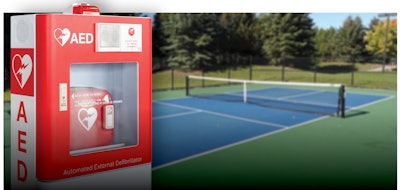
Sam Hopkins suffered a fatal heart attack last summer at the age of 56 while playing pickleball at Halpatiokee Park in Martin County, Fla. At the time of his death, the park didn’t have an automated external defibrillator available. In the wake of Hopkins’ death, more than 120 pickleball players raised enough money to purchase three AEDs, and each is brought to the park by a designated player each day. The problem is they’re not available 24/7, which has led to a push to have the county parks department install permanent AEDs in Martin County parks.
According to the American Heart Association, the survival rate from cardiac arrest drops by 7 to 10 percent for every minute that a patient has to wait for defibrillation. The survival rate is notably higher among patients who receive their first defibrillation no later than three minutes after the witnessed collapse: 74 percent for those who receive their first defibrillation by the three-minute mark, and 49 percent for those who receive their first defibrillation at three minutes or later.
Martin County’s pickleball players are not alone in their push to have permanent AEDs installed at parks and outdoor sports fields. Parks departments across the country are securing funds to make these life-saving devices available to those recreating and spectating in the event tragedy strikes.
A few years ago, the city of Beverly, Mass., began talking about installing AEDs at local parks and sports fields after Kurt and Kelly Anderson’s son Daniel, then 17, was saved by emergency responders using a defibrillator after he went into cardiac arrest playing basketball at a friend’s house. Daniel recovered and is doing well, but the Andersons, along with help from Beverly volunteers, started a nonprofit called Ready to React, which went to work raising money for two AEDs that were installed at Beverly High School and a local theater.
When the Andersons approached Beverly mayor Mike Cahill about getting AEDs installed at local parks, the idea was met with enthusiasm by Cahill, as well as parks director Bruce Doig.
“The Andersons came to me and mayor Cahill, and they wanted to do units at the fields,” explains Doig. “And with what happened with Damar Hamlin of the Buffalo Bills, that really raised eyebrows about the need to have more units at playing fields.”
The initial push, along with donations and the efforts of Ready to React, led to two AED units being installed at local softball fields, and then four at Beverly's youth soccer fields. The effort just snowballed from there, as more entities took notice and got involved, and more money was made available.
“We’ve gone quickly from one unit to 22 or so with the help of the Beverly Youth Soccer Association, the Friends of Beverly Recreation, the David Lynch Trustees, and then mayor Cahill approving the budget for us to order the units,” says Doig, adding that the ultimate goal is to have 36 units around the city.
While Ready to React offers CPR and AED operating instruction, the AED units installed in Beverly are easy to use. The power is hardwired, and when a user opens the case, lights flash and alarms sound, alerting those in the area of an emergency. Once the case is opened, the unit offers the user instructions on how to use the defibrillator.
“These days the units are so sophisticated you don’t really need training to use them,” says Doig. “That said, any training we can do will help alleviate fears of somebody trying to use the units. If someone is afraid to use the units, and then it doesn’t get done in a timely manner or in a proper manner, obviously that’s not good. But the units tell you exactly what to do and how to do it and when to do it.”
Moreover, the readily accessible units are designed to prevent nefarious use. “They can’t be used to shock somebody if the person isn’t totally unconscious,” Doig says. “I don’t love to use the word foolproof, but really anybody can take it out of the box and use it and follow the simple instructions.”
For municipalities considering installing AEDs at parks or sports fields, Doig notes that a proper maintenance plan should be in place. The units Beverly has purchased have a battery warranty of five to seven years, but given that the units are permanently installed in public places, they should be regularly inspected for tampering or inoperability. The pads also have to be swapped out occasionally, as they can expire and lose their stickiness. Beverly will also be installing signage to ensure that park and field patrons know exactly where the AEDs are located, should trouble arise.
“We also plan to create a safety and inspection plan so that somebody could go around to all of the fields regularly, whether it’s weekly or every other week, and look to make sure the unit opens, check the pads and make sure everything’s in there,” says Doig. “We did talk about using breakable zip ties so that if you get to a field and the zip tie is still intact, you know that nobody’s opened it. If you get to a field and the tie is broken, then you know somebody opened it, and you have to inspect it. We’ll have eyes on these things regularly.”
For Doig, the installation of the AEDs in Beverly’s parks and near sports fields offers him peace of mind. “It’s the right thing to do,” he says. “Obviously, we’re hoping we never have to use it. But not having them there will be much more troubling if something does happen, and we’re not ready for it. Working with Kelly and Kurt, it’s just been a great project. I’ve really enjoyed working on it and am very proud of the fact that the city has stepped up and taken control of this.”





































